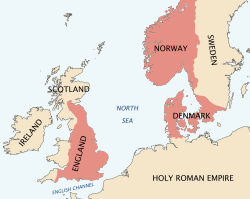North Sea Empire
| North Sea Empire | ||||||||||||||||||
|
||||||||||||||||||
|
The dominions of Cnut the Great.
|
||||||||||||||||||
| Capital | No common capital | |||||||||||||||||
| Languages | Old Norse, Old English | |||||||||||||||||
| Religion | Christianity, Germanic paganism | |||||||||||||||||
| Government | Monarchy | |||||||||||||||||
| King | ||||||||||||||||||
| • | 1016–1035 | Cnut the Great | ||||||||||||||||
| Historical era | Viking Age | |||||||||||||||||
| • | Battle of Assandun | 18 October 1016 | ||||||||||||||||
| • | Death of Cnut | 12 November 1035 | ||||||||||||||||
|
||||||||||||||||||
| Today part of |
5 sovereign countries
|
|||||||||||||||||
The North Sea Empire or Anglo-Norse Empire is the name usually given to the kingdoms ruled by Cnut the Great as king of England, Denmark, Norway and parts of what is now Sweden between 1016 and 1035. It can also be called more specifically the Anglo-Scandinavian Empire. As one historian put it:
When the 11th century began its fourth decade, Canute was, with the single exception of the Emperor, the most imposing ruler in Latin Christendom. ... [H]e was lord of four important realms and the overlord of other kingdoms. Though technically Canute was counted among the kings, his position among his fellow-monarchs was truly imperial. Apparently he held in his hands the destinies of two great regions: the British Isles and the Scandinavian peninsulas. His fleet all but controlled two important seas, the North and the Baltic. He had built an Empire.
Cnut was the younger son of the Danish king Sweyn Forkbeard. When his father died on 3 February 1014 during an invasion of England, Cnut, who had been left in command of the fleet in the River Trent while Sweyn was in the south of England, was acclaimed by the Danes. However, the invasion fell apart: the men of the Kingdom of Lindsey, who had promised to supply horses for a tactical raid, were not ready before the English nobles had reinstalled King Æthelred, whom they had previously sent into exile, after forcing him to agree to govern less harshly.
Cnut's brother Harald became king of Denmark, but with help from Eric Haakonsson of Norway, Cnut raised a new invasion fleet of his own and returned to England in summer 1015. The English were divided by intrigue among the king, his sons, and other nobles; within four months one of Æthelred's sons had pledged allegiance to Cnut and he controlled Wessex, the historic heart of the kingdom. Before the decisive battle for London could be fought, Æthelred died on 23 April 1016. The Londoners chose his son Edmund as their king, while most of the nobles met at Southampton and swore fealty to Cnut. Cnut blockaded London, but was forced to leave to replenish his supplies and beaten by Edmund at the Battle of Otford; however, following the Danes as they raided into Essex, Edmund was in turn defeated at the Battle of Assandun. He and Cnut struck an agreement under which Edmund would retain Wessex and Cnut rule all of England north of the Thames. But on 30 November 1016, Edmund in turn died, leaving Cnut king of England.
...
Wikipedia

